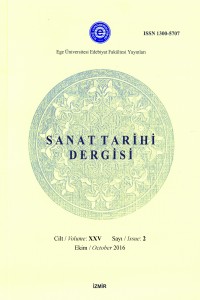Abstract
Yapı, İzmir’in yaklaşık 113 kilometre güneydoğusunda yer alan Ödemiş ilçesinde, çarşı içindedir. Kareye yakın dikdörtgen bir alan üzerine oturan yapı ahşap desteklerin taşıdığı ahşap tavanlı bir harim ve önünde, kuzeyde ve batıda toplam 11 ahşap destek tarafından taşınan bir son cemaat yerinden oluşmaktadır. Duvarları içte ve dışta sıvalı olduğu için inşa malzemesi anlaşılamamaktadır. Kuzey cephe önünde, yapıyı üç yönden çevreleyen avlu duvarı yakın zamanda inşa edilmiştir. Harimin güney duvarı üzerinde yer alan, yarım daire şekilli mihrap nişinin iki yanına, yarısı duvara gömülü birer sütunce yerleştirilmiştir. Üzerleri diğer destekler gibi boyalı olan sütuncelerin başlıkları da kenger yapraklarından oluşmaktadır. Ana niş kemeri üzerinde kalemişi olarak işlenmiş bitkisel süslemeli bir pano, tepeliğin merkezinde ayna perspektifiyle yazılmış bir besmele panosu ve bunu çevreleyen yine kenger yapraklarının işlendiği kalemişi bitkisel bir tepelik yer almaktadır.
İnşa kitabesi bulunmayan yapının girişi üzerinde yer alan onarım kitabesi 1856 tarihlidir. Çeşitli yayınlarda yapının, 1665 yılında, Tireli Kabasakal oğlu Mehmed Ağa tarafından küçük bir mescid olarak inşa edildiği, halk tarafından “Bani Camii” adıyla anıldığı, 1856’da onarıldığı belirtilmektedir.
Keywords
References
- Armağan, A. M. (2011), Osmanlı Belgelerinde Ödemiş, Ödemiş.
- Barışta, H. Ö. (2009), İzmir’den Kuş Evleri, XI. Ortaçağ-Türk Dönemi Kazı Sonuçları ve Sanat Tarihi Araştırmaları Sempozyumu [17-19 Ekim 2007, İzmir] Bildirileri, İzmir.
- Dural, H. (2004), Ödemiş Tarihi, (Yay. Haz. Sabri Yetkin), İzmir: Ödemiş Belediyesi Kültür Yayınları.
- Gürbıyık, C. (2010), Karaburun Yarımadası’nda Türk Mimarisi, İstanbul: Arkeoloji ve Sanat Yayınları.
- İbn-i Battûta [2004], Ebu Abdullah Muhammed İbn Battûta Tancî, İbn Batûtta Seyahatnamesi C.I, A. Sait Aykut (Çev.), İstanbul: YKY.
- Kamer, M. (3514), Ödemiş Büyük Cami ve Kitabeleri, http://www.tarihistan.org/yazarlar/mehmet-kamer/odemis-buyuk-camii-ve-kitabeleri/3514/ .
- Kiel, M. (2001), Batı Anadolu’da Eski bir Türk Kültür Merkezi, Birgi. Tarihi, Tarihî Coğrafyası ve Türk Dönemi Anıtları, (Yay. Haz. R. H. Ünal), Ankara: T.C. Kültür Bakanlığı.
- Kuran, A. (1972), Anadolu’da Ahşap Sütunlu Selçuklu Mimarisi, Malazgirt Armağanı, 179-181. Ankara.
- Öney, G. (1989), Beylikler Devri Sanatı - XIV-XV. Yüzyıl (1300-1453), Ankara.
- Tül, Ş. (2014), Artemis Yolu Üstünde İlk Çağ Kenti Hypaipa, Ödemiş.
- Ünal, R. H. (1994), Yukarı Kızılca Köyü Halil Ağa Camii, Sanat Tarihi Dergisi VII, 211-225, İzmir: Ege Üniv. Edebiyat Fakültesi Yayınları.
- Yavuz, B. G. (1998), Ödemiş’in Tarihi, Ödemiş.
- Yavuz, B. G. (2005), Birgi. Coğrafyası, Halk Bilgisi, Tarihçesi, Tarihi Yerleri, İzmir.
Abstract
The structure is situated in the bazaar of Odemis, 113 km southeast of Izmir Built on a foundation of rectangle, very close to a squre, it consists of a prayer hall (harim) with a wooden roof supported by wooden structures preceded by nartex supported by 11 wooden columns on nothern and western sides. Since the walls are plastered on both the exterior and interior, the construction material is not understood. The courtyard wall surrounding the structure on three side was built recently on the northern side. On the southern wall of the prayer hall, on both side of the semi circle shaped prayer nich (mihrap), two columns -pilaster shaped - semi buried are added as decoration. These pilasters surfaces are painted the same as other wooden structures and they have capitals decorated with thistle (kenger) leaves. On the arch of central niche, there is a panel with stenciled floral motif. Above the arch at the center, in another panel there is symetrical double alternating Arabic calligraphy of “besmele” - by the name of god, this inscription is, also, surrounded by thistle leaves stenciled reliefs.
The structure which does not have built inscription has a panel on the top of the entrance indicating a construction in 1665 by Mehmet Aga- son of Kabasakal from Tire, as small mosque -masjid-, and mentioning that it was known as “Banii Mosque” and that it was restored in 1856.
Keywords
References
- Armağan, A. M. (2011), Osmanlı Belgelerinde Ödemiş, Ödemiş.
- Barışta, H. Ö. (2009), İzmir’den Kuş Evleri, XI. Ortaçağ-Türk Dönemi Kazı Sonuçları ve Sanat Tarihi Araştırmaları Sempozyumu [17-19 Ekim 2007, İzmir] Bildirileri, İzmir.
- Dural, H. (2004), Ödemiş Tarihi, (Yay. Haz. Sabri Yetkin), İzmir: Ödemiş Belediyesi Kültür Yayınları.
- Gürbıyık, C. (2010), Karaburun Yarımadası’nda Türk Mimarisi, İstanbul: Arkeoloji ve Sanat Yayınları.
- İbn-i Battûta [2004], Ebu Abdullah Muhammed İbn Battûta Tancî, İbn Batûtta Seyahatnamesi C.I, A. Sait Aykut (Çev.), İstanbul: YKY.
- Kamer, M. (3514), Ödemiş Büyük Cami ve Kitabeleri, http://www.tarihistan.org/yazarlar/mehmet-kamer/odemis-buyuk-camii-ve-kitabeleri/3514/ .
- Kiel, M. (2001), Batı Anadolu’da Eski bir Türk Kültür Merkezi, Birgi. Tarihi, Tarihî Coğrafyası ve Türk Dönemi Anıtları, (Yay. Haz. R. H. Ünal), Ankara: T.C. Kültür Bakanlığı.
- Kuran, A. (1972), Anadolu’da Ahşap Sütunlu Selçuklu Mimarisi, Malazgirt Armağanı, 179-181. Ankara.
- Öney, G. (1989), Beylikler Devri Sanatı - XIV-XV. Yüzyıl (1300-1453), Ankara.
- Tül, Ş. (2014), Artemis Yolu Üstünde İlk Çağ Kenti Hypaipa, Ödemiş.
- Ünal, R. H. (1994), Yukarı Kızılca Köyü Halil Ağa Camii, Sanat Tarihi Dergisi VII, 211-225, İzmir: Ege Üniv. Edebiyat Fakültesi Yayınları.
- Yavuz, B. G. (1998), Ödemiş’in Tarihi, Ödemiş.
- Yavuz, B. G. (2005), Birgi. Coğrafyası, Halk Bilgisi, Tarihçesi, Tarihi Yerleri, İzmir.
Details
| Journal Section | RESEARCH |
|---|---|
| Authors | |
| Publication Date | December 30, 2016 |
| Published in Issue | Year 2016 Volume: 25 Issue: 2 |


